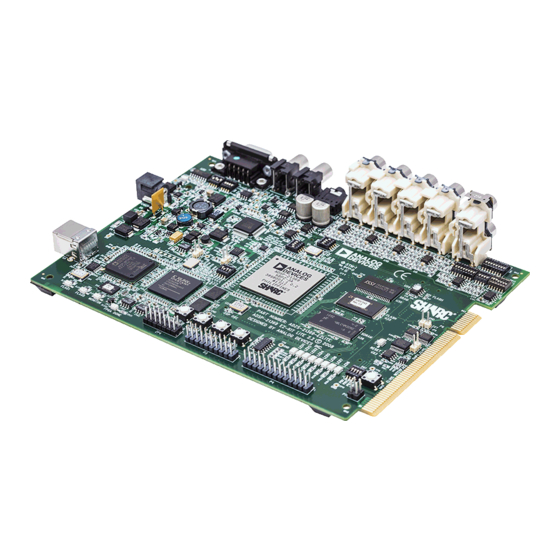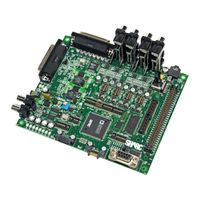
Analog Devices SHARC ADSP-21367 Manuals
Manuals and User Guides for Analog Devices SHARC ADSP-21367. We have 3 Analog Devices SHARC ADSP-21367 manuals available for free PDF download: Hardware Reference Manual, Getting Started Manual, Manual
Analog Devices SHARC ADSP-21367 Hardware Reference Manual (894 pages)
Brand: Analog Devices
|
Category: Computer Hardware
|
Size: 4 MB
Table of Contents
-
Preface31
-
Myanalog.com37
-
Conventions43
-
Introduction45
-
Addressing85
-
Uart Dma100
-
Summary104
-
External Port109
-
Channel Freezing126
-
Wait States129
-
Bus Idle Cycles130
-
Bus Hold Cycles131
-
Data Packing133
-
Data Packing135
-
SDRAM Controller138
-
SDC Operation166
-
Data Mask (DQM)169
-
SDC Commands171
-
Precharge All174
-
Read/Write175
-
Auto-Refresh178
-
SDRAM Timing182
-
Pin Interface212
-
DAI Interrupts268
-
DPI Interrupts269
-
Serial Ports281
-
Features282
-
Operation Modes283
-
Clocking Options293
-
Data Formatting294
-
Data Transfers295
-
I2S Mode300
-
Packed I2S Mode313
-
SPORT Loopback315
-
Word Length323
-
Endian Format325
-
Data Type326
-
Companding327
-
SPORT Reset351
-
SPORT Interrupts352
-
SPICLK Timing377
-
SPI Enable381
-
DMA Chaining399
-
SPI Word Lengths403
-
Packing404
-
SPI Interrupts405
-
Input Data Port419
-
Serial Inputs421
-
Masking427
-
Packing Mode 11428
-
Packing Mode 10429
-
Packing Mode 01429
-
Packing Mode 00430
-
Hold Input430
-
PDAP Strobe432
-
Simple DMA438
-
Ping-Pong DMA440
-
FIFO Overflow448
-
Dead Time458
-
Duty Cycles459
-
Over Modulation464
-
Update Modes467
-
Single Update467
-
Crossover468
-
PWM Accuracy469
-
PWM Registers470
-
Duty Cycles471
-
Output Enable472
-
Subframe Format479
-
Channel Coding481
-
Preambles482
-
Channel Status485
-
Standalone Mode489
-
S/PDIF Receiver492
-
Error Handling498
-
Interrupts500
-
Control Register500
-
Control Register501
-
SRU1 Programming502
-
Receiver Locking502
-
Status Bits502
-
Conceptual Model508
-
Hardware Model511
-
Group Delay516
-
SRC Operation516
-
Enabling the SRC517
-
Data Format517
-
TDM Input Mode520
-
Bypass Mode522
-
Mute Control523
-
Soft Mute524
-
Hard Mute524
-
Auto Mute524
-
SRC Registers525
-
SRU Programming526
-
I/O Mode541
-
Packing Mode543
-
Overview545
-
Architecture546
-
TWIDIV Register549
-
Bus Arbitration556
-
Fast Mode558
-
General Setup559
-
Slave Mode559
-
Clock Outputs569
-
Normal Mode571
-
Bypass Mode572
-
Frame Sync574
-
Phase Shift575
-
Pulse Width576
-
Bypass Mode578
-
14 System Design593
-
Pin Multiplexing594
-
Clock Derivation605
-
RESET and CLKIN612
-
Reset Generators619
-
Booting629
-
SPI Port Booting634
-
Slave Boot Mode639
-
Master Boot640
-
Execution Stalls645
-
DAG Stalls646
-
Memory Stalls646
-
DMA Stalls648
-
Spidmacb709
-
Idp_Dma_Ix718
-
Idp_Dma_Mx719
-
Idp_Dma_Cx719
-
Registers (Picrx812
-
Register (PICR3818
-
Index857
Advertisement
Analog Devices SHARC ADSP-21367 Getting Started Manual (114 pages)
SHARC Series
Brand: Analog Devices
|
Category: Computer Hardware
|
Size: 2 MB
Table of Contents
-
Preface
9 -
-
-
-
EZ-KIT Lite42
-
EZ-Board43
-
EZ-Boards66
-
Debug Agent76
-
Scenario 190
-
Scenario 291
-
-
-
-
-
Visualdsp++ Help106
-
Engineerzone107
-
Myanalog.com108
-
Analog Devices SHARC ADSP-21367 Manual (56 pages)
SHARC Processors
Brand: Analog Devices
|
Category: Computer Hardware
|
Size: 0 MB
Table of Contents
Advertisement
Advertisement
Related Products
- Analog Devices EZ-KIT Lite ADSP-21364
- Analog Devices SHARC ADSP-21368
- Analog Devices SHARC ADSP-21369
- Analog Devices SHARC ADSP-21362
- Analog Devices SHARC ADSP-21363
- Analog Devices SHARC ADSP-21365
- Analog Devices SHARC ADSP-21366
- Analog Devices SHARC ADSP-21371
- Analog Devices SHARC ADSP-2136 Series
- Analog Devices SHARC ADSP-2147 Series


